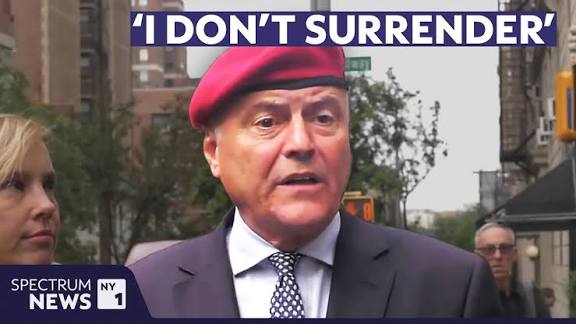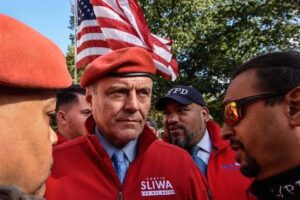curtis sliwa: Refusing to drop out,Resisting pressure,Endorsements & intra‐Republican conflicts

A special version of Up Close with Bill Ritter this week is now just more than four weeks away with choice. Today we will discuss about curtis sliwa: Refusing to drop out,Resisting pressure,Endorsements & intra‐Republican conflicts
curtis sliwa: Refusing to drop out,Resisting pressure,Endorsements & intra‐Republican conflicts
Curtis Sliwa, founder of the Guardian Angels and perennial New York City political figure, has taken center stage in the 2025 mayoral contest. But what’s grabbing headlines isn’t just his platform — it’s his unyielding refusal to drop out despite mounting pressure. In a campaign that’s become increasingly fractious, Sliwa is positioning himself as a bulwark against consolidation efforts within his own party and beyond.
To understand the stakes, one must see not only what Sliwa is doing, but why he feels compelled to stay in, who is pushing him to quit, and what alliances (or rivalries) are emerging as he resists.
1. From Guardian Angels Founder to Relentless Candidate

Before diving into the bitter present, a brief background is helpful.
Curtis Sliwa first gained public fame by founding the Guardian Angels in the late 1970s — a citizen safety patrol group meant to deter street crime. Over decades, he blended activism, media (as radio talk show host), and occasional forays into politics.
In February 2025, he formally announced his candidacy for New York City mayor, running again as a Republican. His campaign platform includes law-and-order themes, opposition to congestion pricing, cuts to fines and fees, and appeals to working-class New Yorkers.
But more than policy, his campaign is increasingly being defined by his defiance under pressure.
2. Pressure to Drop Out: A Campaign Under Siege
2.1 The Call to Consolidate
A key factor in Sliwa’s predicament is the notion, repeatedly voiced by political operatives and wealthy backers, that the field should “coalesce” behind a single anti-Mamdani candidate (i.e. someone who can realistically beat socialist-leaning Zohran Mamdani).
The logic: multiple non-socialist candidates risk splitting the vote and handing victory to Mamdani. Some believe Andrew Cuomo, now running as an independent, is the best shot.
Hence, increasing pressure on Sliwa (and on Eric Adams before he withdrew) to exit the race so as not to dilute the anti-Mamdani vote.
2.2 Alleged Bribes, Offers, and Financial Temptations
Sliwa claims that major donors and wealthy backers have attempted to induce him to quit — offering money, resources for his Guardian Angels or his wife’s animal welfare programs, even a high-paying security job.
He alleges these overtures total up to $10 million. In public statements, he’s cast them as attempts at bribery.
Sliwa has vowed to record and report further such offers to relevant authorities.
Whether those offers are real or exaggerated is fiercely disputed. Cuomo’s team has denied involvement; some dismiss Sliwa’s claims as political theater.
2.3 Internal Party Pressures
Pressure hasn’t only come from outsiders. Internal voices — within the Republican establishment or from donors — have suggested he consider stepping aside. One such voice is John Catsimatidis, his radio employer, who has publicly stated that if Sliwa doesn’t improve in polls, “the machine is kaput.”
Still, Sliwa frames this as a test of mettle: he repeatedly emphasizes he does not “surrender” or “retreat.”
2.4 Threats to His Viability
The pressure is not just rhetorical. His campaign is already lagging in the polls — with Sliwa often polling third behind Mamdani and Cuomo.
Public perception of “spoiler candidate” looms large. Critics warn that his continued presence could cost the anti-Mamdani cause.
There’s also speculation on financial and institutional sustainability: if he continues without growth, will major donors or party machinery abandon him? That becomes a real risk in any campaign.
3. Refusing to Fold: Sliwa’s Strategy of Resistance
So how is Sliwa handling this maelstrom?
3.1 Messaging of Defiance
Sliwa’s language is unambiguous. He says, “I don’t surrender, I don’t retreat.” He rejects being treated as a bargaining chip — he insists he is not for sale. In private and public, he frames himself as a principled fighter, not someone who folds under pressure.
On the day Eric Adams dropped out, Sliwa used the moment to re-center the campaign: “Let’s get back to the race” — turning the narrative away from dropouts and back to issues.
3.2 Emphasizing Consistency and Credibility
Sliwa often points out that he consistently supported a run, even when others dropped earlier, positioning his steadfastness as integrity. He argues dropping now would make him look foolish — especially in light of Adams’ withdrawal.
Moreover, he frames his candidacy as offering New Yorkers a real choice — an alternative to entrenched political elites.
3.3 Leaning on Grassroots and Donor Base
Despite weak polling, Sliwa has mustered tangible financial support. Reports claim he has raised $3.4 million from over 7,000 donors. He also positions himself as a critical flagbearer for Republicans down-ballot — implying that exiting would harm the broader party’s prospects.
This is a common tactic: telling donors and party actors that his withdrawal would create damage and uncertainty downstream.
3.4 Rejecting Quid-Pro Quo Offers
Sliwa says he has declined multiple job offers proffered in exchange for his exit. He frames such offers as ethically corrupt and possibly illegal. He has threatened that any further such overtures, if recorded, will be reported to law enforcement.
By doing so, he reinforces an image of incorruptibility — or at least a hard line against transactional politics.
4. Endorsements, Ambitions & Political Alliances
Endorsements — or the lack thereof — play a key role in Sliwa’s campaign narrative and internal positioning.
4.1 Endorsements Received and Lacking
Sliwa’s campaign claims backing from Republican organizations across NYC. But in terms of high-profile endorsements, the picture is mixed and contentious.
Donald Trump has publicly pushed Sliwa to drop out in favor of a “one-on-one” race with Mamdani. That suggests Trump is not enthusiastic about Sliwa’s candidacy in practice.
But Sliwa’s relationship with Trump is complicated. He hasn’t spoken with Trump for years, and their past interactions include public criticism and satire. Sliwa has even warned that an endorsement from Trump might energize his opponent more than help him.
Other endorsements are more modest — local Republican leaders and donors who continue to support his candidacy over the consolidation arguments.
4.2 Intra-Republican Conflict: Cuomo, Adams, and Party Elites
Sliwa’s campaign exists amid a swirl of intra-Republican maneuvering. The push to get him out of the race is often framed as a “save the city from Mamdani” move — but it also reflects a belief among some elites that Cuomo is a more viable vessel for anti-socialist votes.
Eric Adams, before withdrawing, reportedly lobbied to attain the GOP nomination by replacing Sliwa — a strategy blocked by Republican county chairs.
Sliwa’s rejection of being replaced or being booted in favor of someone else is part of his insistence that he alone deserves the party line.
This creates tension: Sliwa is not just resisting external pressure, but resisting internal party efforts to reshape the ballot. The Republican establishment is split — some see pragmatism in consolidation; others see surrender in asking Sliwa to step down.
4.3 Ambitions Beyond the Mayoral Race
Sliwa likely sees more than a city job in this race. His high-profile stance — refusing inducements, standing his ground — may be aimed at positioning himself as a maverick Republican voice in broader state or national politics.
By rejecting compromise overtures, he cultivates an image that might appeal to more hardline or anti-establishment factions within the party. In other words, beyond winning, he’s signaling for future leverage.
5. Risks, Consequences, and Strategic Calculus
Sliwa’s defiance is bold, but risky. Below are core potential upsides and hazards.
5.1 Potential Upsides
-
Branding as a Fighter: By refusing to bow to pressure, he can strengthen his core base and solidify a perception of integrity.
-
Leverage in Negotiations: If his standing holds, he might bargain for influence, endorsements, or roles in future Republican leadership.
-
Deterrence of Manipulation: His public posture may deter further attempts to bribe or sideline him — or at least raise the cost for would-be dealmakers.
5.2 Key Risks
-
Spoiler Effect: If his candidacy siphons anti-Mamdani votes, he may indirectly contribute to the very outcome he opposes.
-
Alienation from Party Machinery: Establishment Republicans may withdraw support or redirect funds.
-
Financial Vulnerability: If fundraising slows, sustaining operations becomes harder.
-
Diminished Credibility: If claims of bribery or offers are proved false, critics will pounce on dishonesty.
-
Polling Irrelevance: Continued weak polling may marginalize him — making it harder to attract attention or endorsements.
Sliwa’s bet is simple: the reward for staying in (either winning or emerging as a political force) outweighs the cost of abiding by consolidation pressures.
6. Narrative Framing & Public Perception
Sliwa’s media posture is carefully disciplined. He consistently frames:
-
Others as subservient to money — he is not.
-
Pressure as a betrayal of democracy — billionaires and elites trying to pick the mayor.
-
His campaign as a mission, not a transaction — people vs. politics.
At campaign stops, he leans into symbolism: wearing his red beret, campaigning in subways, engaging with passersby who jeer or heckle. He paints a David vs. Goliath image: the challenger against insiders.
Critics, however, have countered that this is theater — a veneer masking a campaign too weak to make waves. Cuomo’s camp has called his bribery allegations false and baseless, accusing him of repeating past fabrications.
The high-stakes question: will public perception tilt toward admiration for grit — or weary dismissal of a longshot?
7. The Path Ahead: What to Watch
As the election looms, several developments merit close observation:
-
More Bribe Allegations — Will Sliwa name names or produce evidence? If he does, it could shake up the race.
-
Shifts in Endorsements — Which high-profile figures decide to support Sliwa (or pull away)?
-
Polling Trajectory — Can Sliwa break into a competitive bracket, or will he remain fringe?
-
Donor Behavior — Will deeper-pocket supporters remain on board?
-
Republican Party Moves — Are there renewed attempts to replace him, or will the party convene behind him?
-
Media Narrative — Will Sliwa’s defiance be cast as heroic or foolhardy?
8. Conclusion
Curtis Sliwa’s 2025 mayoral campaign is less about policy (though those matter) and more about a personal and political drama: the refusal to drop out, resist inducements, forge identity in the face of pressure, and stand apart within his own party.
He’s not merely battling opponents from other parties — he’s resisting a kind of internal elimination process. That tension gives the campaign its drama and political intrigue. Whether Sliwa’s stand is a masterstroke or a miscalculation remains to be seen.
But one thing is clear: in a political era dominated by consensus and strategic mergers, Curtis Sliwa is daring to be the candidate who says “No.”
How useful was this post?
Click on a star to rate it!
Average rating 0 / 5. Vote count: 0
No votes so far! Be the first to rate this post.
About the Author
usa5911.com
Administrator
Hi, I’m Gurdeep Singh, a professional content writer from India with over 3 years of experience in the field. I specialize in covering U.S. politics, delivering timely and engaging content tailored specifically for an American audience. Along with my dedicated team, we track and report on all the latest political trends, news, and in-depth analysis shaping the United States today. Our goal is to provide clear, factual, and compelling content that keeps readers informed and engaged with the ever-changing political landscape.




